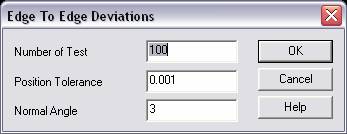KeyCreator / Verify / Deviation / Edge to Edge

This function will measure for maximum deviation from the edge boundary of one surface to the edge boundary of another surface in cases where positional and normal vector continuity (tangency) is desired, such as with adjacent surfaces.
A specified number of points will be distributed along the specified boundary of the first surface selected.
-
Each point will be evaluated for its minimum distance to the corresponding boundary of the adjacent surface. Also, the surface normals at each point will be compared for parallelism.
-
If any points exceed a specified 'deviation tolerance' threshold or if any normals exceed a specified 'angular tolerance' threshold, this data will be reported back to you as permanent entities displayed on the screen. These tolerances can be adjusted at the parameter menu.
-
After evaluating, you will be notified as to how many, if any, of the specified points exceeded the position deviation tolerance. The location of these points will also be displayed on the screen. This information, and the information in steps 7 and 8, appear in a ”r;Data Verify” dialog.
-
Next, you will be notified as to how many, if any, of the normal vectors at the specified points exceeded the angular deviation tolerance. The location of these vectors will be displayed on the screen.
-
Finally, you will be notified of the maximum positional and angular deviations and model the maximum deviations as point and vector entities.
Using the Function:

-
Select Edge to Edge from the Verify>Deviations submenu. The Edge to Edge Deviations dialog box appears.
-
Number of test points - along the specified boundary.
-
Position Tolerance - The minimum positional deviation tolerance for which points will be displayed.
-
Normal Angle - The minimum angular deviation tolerance for which vectors will be displayed.
-
Either accept/OK the preset default values or select the parameter you wish to change. Adjust the values as needed.
-
When all values are satisfactory, click OK to initiate the evaluation.
-
To have a basis for the comparison, select a free edge of one surface and a free edge of another surface to compare against.
|
